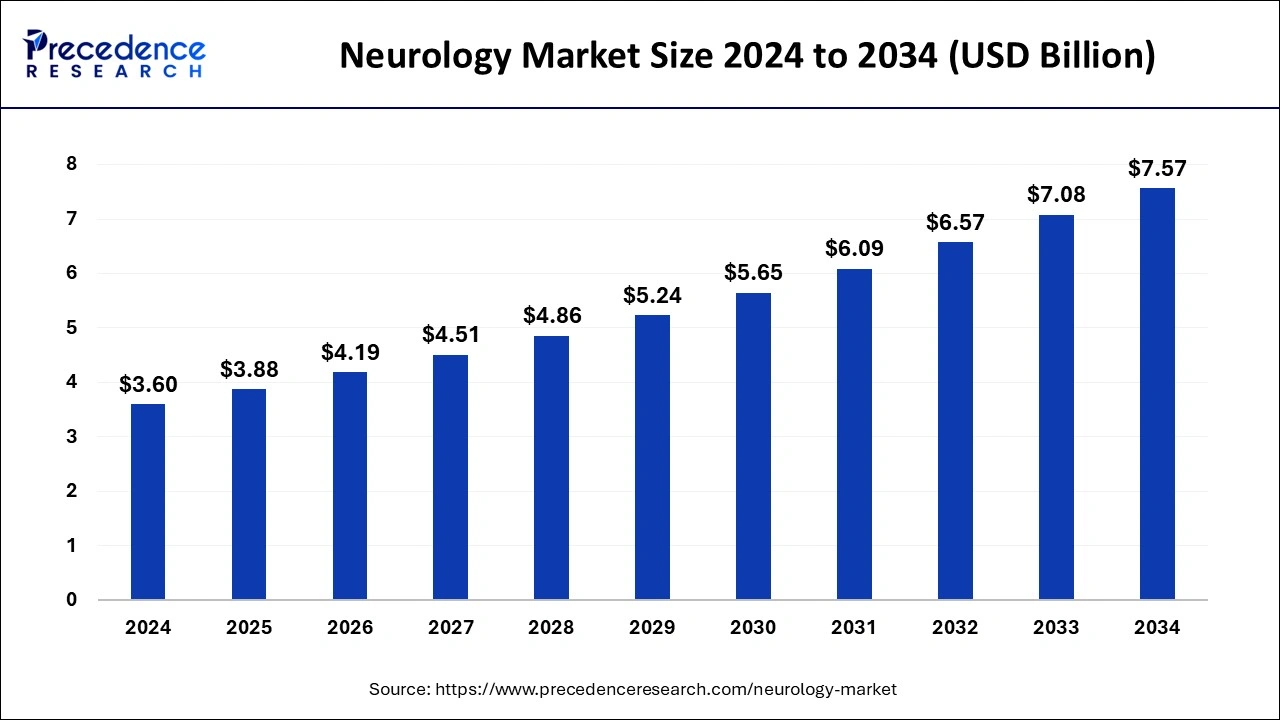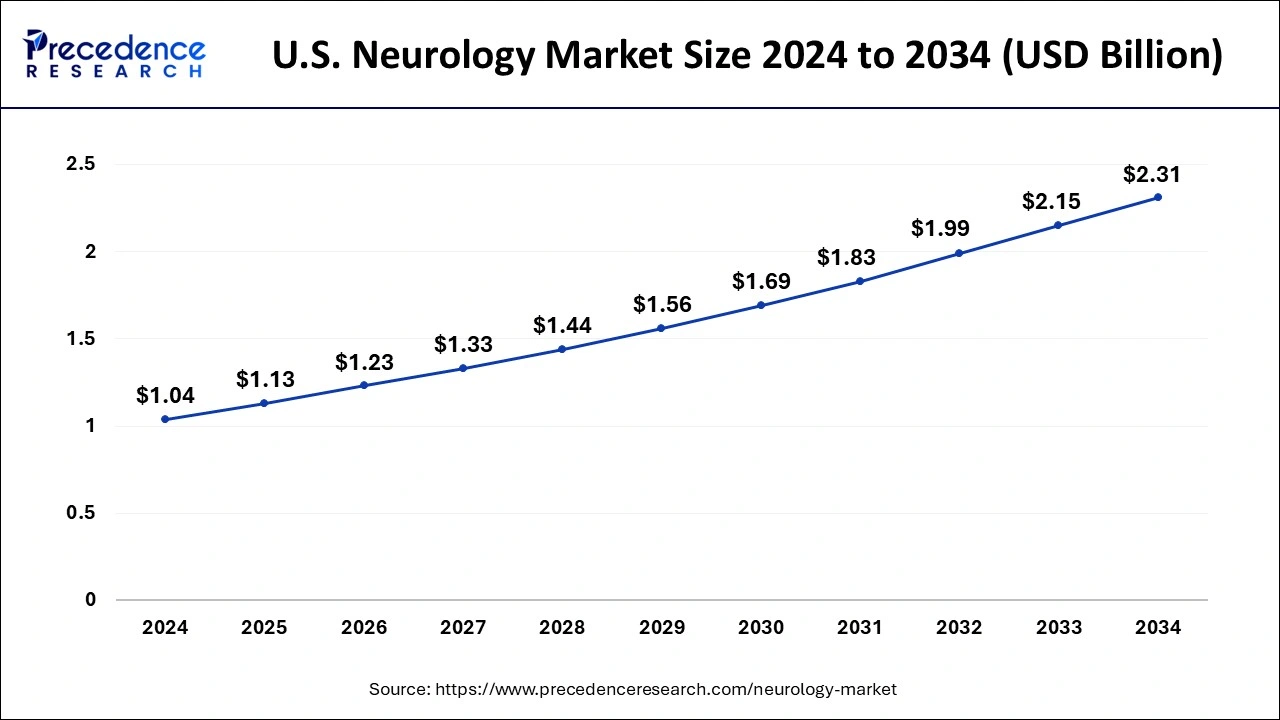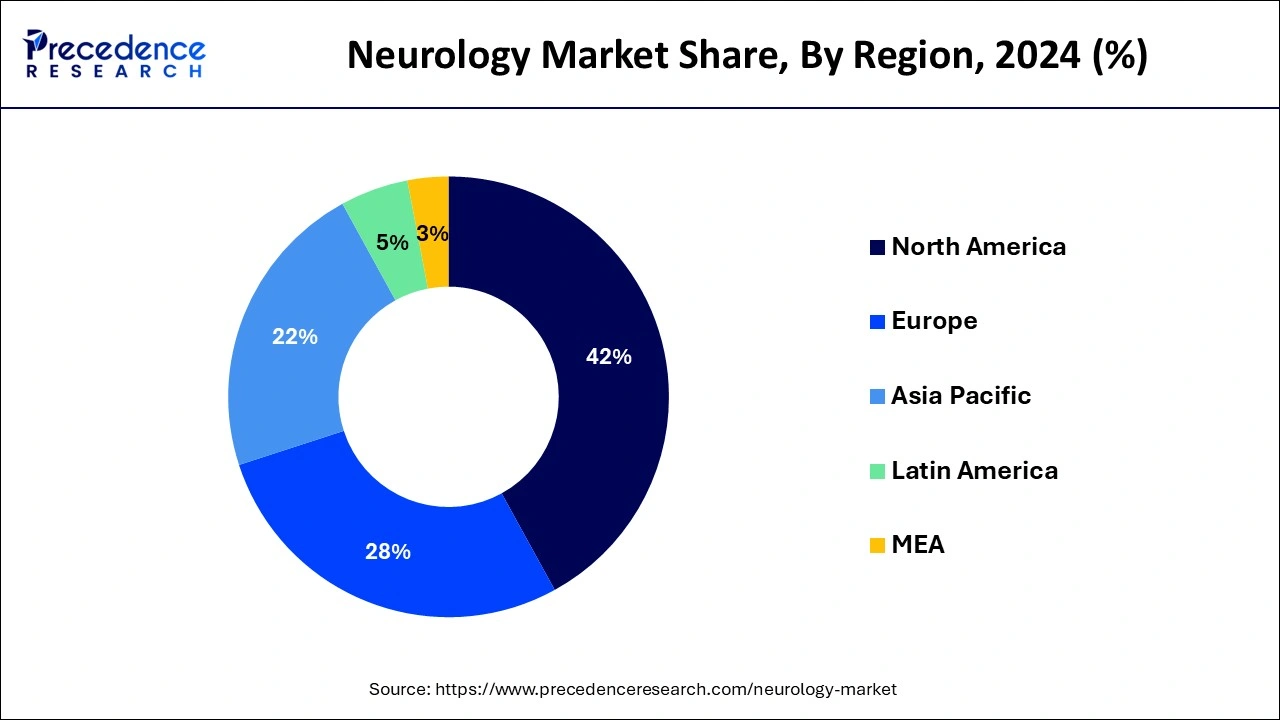February 2025
The global neurology market size is accounted at USD 3.88 billion in 2025 and is forecasted to hit around USD 7.57 billion by 2034, representing a CAGR of 7.72% from 2025 to 2034. The North America market size was estimated at USD 1.51 billion in 2024 and is expanding at a CAGR of 7.73% during the forecast period. The market sizing and forecasts are revenue-based (USD Million/Billion), with 2024 as the base year.
The global neurology market size was estimated at USD 3.60 billion in 2024 and is predicted to increase from USD 3.88 billion in 2025 to approximately USD 7.57 billion by 2034, expanding at a CAGR of 7.72% from 2025 to 2034.

The U.S. neurology market size was evaluated at USD 1.04 billion in 2024 and is projected to be worth around USD 2.31 billion by 2034, growing at a CAGR of 8.31% from 2025 to 2034.

North America has held the largest revenue share of 42% in 2024. In North America, the neurology market is propelled by robust research and development activities, cutting-edge technologies, and a well-established healthcare infrastructure. The region witnesses significant investments in neurology research, leading to advancements in diagnostics, therapeutics, and innovative treatment modalities. Patient-centric approaches and collaborations between industry players and research institutions contribute to the continual growth of neurology services in North America.
Asia Pacific is estimated to observe the fastest expansion. Asia Pacific experiences a growing demand for neurology services driven by an expanding population, increasing awareness of neurological disorders, and improving healthcare access. Rising healthcare expenditure and government initiatives to address neurological diseases further enhance the neurology market's prominence in the region. As healthcare systems in Asia-Pacific continue to evolve, there is a notable increase in neurology-focused research and the adoption of advanced technologies, shaping the landscape of neurological care in the region.
In Europe, the neurology market thrives on a robust healthcare system, sophisticated medical research, and a strong commitment to addressing neurological disorders. The region showcases a high level of expertise in neurology, with renowned research institutions and healthcare facilities driving advancements in diagnostics, treatments, and patient care. Collaborations between European countries contribute to a cohesive approach to neurology, ensuring access to cutting-edge therapies and fostering a supportive environment for both research and clinical applications.

The neurology market is a comprehensive domain covering the diagnosis, treatment, and management of disorders affecting the nervous system. Encompassing a wide range of conditions from neurodegenerative diseases like Alzheimer's and Parkinson's to neurovascular issues such as strokes, the market focuses on understanding and addressing disorders of the brain, spinal cord, and nerves.
It involves various medical professionals, diagnostics, and therapeutic interventions, contributing to the development of innovative treatments, diagnostic tools, and research to improve outcomes for patients affected by neurological conditions. The market plays a crucial role in addressing the complex and diverse challenges of neurological health.
| Report Coverage | Details |
| Growth Rate from 2025 to 2034 | CAGR of 7.72% |
| Market Size in 2025 | USD 3.88 Billion |
| Market Size in 2024 | USD 3.60 Billion |
| Market Size by 2034 | USD 7.57 Billion |
| Largest Market | North America |
| Base Year | 2024 |
| Forecast Period | 2025 to 2034 |
| Segments Covered | Type, Procedure, End User, and Application |
| Regions Covered | North America, Europe, Asia-Pacific, Latin America, and Middle East & Africa |
Advances in neuroscience and research collaboration
Advances in neuroscience and collaborative research initiatives significantly contribute to the burgeoning demand in the neurology market. The evolving understanding of the intricate workings of the nervous system, propelled by breakthroughs in imaging technologies and molecular biology, fuels the development of novel diagnostics and therapeutic interventions. These advancements, ranging from deciphering genetic markers to exploring intricate neural networks, pave the way for innovative treatment modalities.
Research collaboration, both across academic institutions and industry players, fosters a collective approach to address the complex challenges posed by neurological disorders. By pooling resources, knowledge, and expertise, collaborative efforts accelerate the development of new drugs, therapies, and diagnostic tools. This synergy not only expedites the translation of scientific discoveries into practical applications but also enhances the overall effectiveness of neurological treatments, meeting the growing global demand for comprehensive and sophisticated solutions in neurology.
Complexity of neurological disorders and high treatment costs
The intricate nature of neurological disorders poses a significant restraint on the neurology market. The complexity arises from the diverse range of disorders affecting the nervous system, each with unique characteristics and underlying mechanisms. Diagnosis and treatment often require specialized expertise, leading to challenges in developing universal solutions. This complexity contributes to the lengthy and resource-intensive research and development process, hindering the rapid introduction of new therapies.
High treatment costs represent another major restraint in the neurology market. The substantial investment in research and technology for the development of advanced diagnostic tools, therapeutic interventions, and pharmaceuticals contributes to the high cost of neurological treatments. This elevated cost creates a barrier to access for a considerable portion of the population, restricting the adoption of state-of-the-art treatments and exacerbating healthcare disparities. Initiatives aimed at addressing these challenges involve fostering research collaborations, securing increased funding, and advancing healthcare delivery models to enhance the accessibility and affordability of neurology services.
Regenerative medicine, neuroinformatic and data analytics
The integration of regenerative medicine into neurology offers innovative approaches for treating neurodegenerative diseases. Stem cell therapies and tissue engineering techniques hold promise for repairing damaged neural tissue, potentially slowing or reversing the progression of conditions like Alzheimer's and Parkinson's. This evolving field sparks research collaborations, clinical trials, and investments, indicating a growing interest in regenerative solutions for neurological disorders.
Neuroinformatic and data analytics play a pivotal role in advancing neurology by leveraging big data and artificial intelligence. The analysis of large datasets enables researchers to identify patterns, predict disease trajectories, and develop targeted interventions. With the increasing digitization of patient records, neuroinformatic facilitates precision medicine approaches, tailoring treatments to individual patient profiles. The combination of regenerative medicine and advanced data analytics propels the neurology market towards more personalized, effective, and data-driven approaches, fostering a new era of innovation and patient care.
According to the type, the neurodegenerative diseases segment has held a 59% revenue share in 2023. Neurodegenerative diseases involve progressive deterioration of the structure and function of the nervous system. Disorders like Alzheimer's and Parkinson's fall into this category. The market trends include a focus on disease-modifying therapies, precision medicine, and early detection through advanced imaging. Growing research on disease mechanisms and potential biomarkers enhances diagnostic accuracy and paves the way for targeted therapies, reflecting a shift towards personalized and effective interventions.
The neurovascular diseases segment is anticipated to expand at a significantly CAGR of 9.1% during the projected period. Neurovascular diseases affect the blood vessels in the brain, leading to conditions like strokes. Market trends in this segment revolve around endovascular treatments, thrombectomy devices, and neurointerventional procedures. Advances in neuroimaging techniques improve diagnostics, while innovations in minimally invasive interventions enhance patient outcomes. The emphasis on rapid and efficient treatments, especially in acute scenarios, drives the neurovascular segment towards more sophisticated and effective solutions.
Based on the procedure, the multiple sclerosis segment held the largest market share of 36% in 2023. Multiple sclerosis (MS) is a chronic autoimmune disease affecting the central nervous system. Trends in MS treatments involve the development of disease-modifying therapies (DMTs) that aim to manage symptoms, slow disease progression, and enhance quality of life.
On the other hand, the epilepsy segment is projected to grow at the fastest rate over the projected period. Epilepsy, a neurological disorder characterized by recurrent seizures, witnesses’ trends in precision medicine, with a focus on identifying biomarkers for individualized treatment plans. Advancements in antiepileptic drugs, neuromodulation techniques, and non-invasive brain stimulation contribute to optimizing seizure control.
In 2024, the adult segment had the highest market share of 69% on the basis of the end user. In adult neurology, the spotlight is on age-related neurodegenerative disorders like Alzheimer's and Parkinson's. Precision medicine and targeted therapies are trending, tailoring interventions based on individual patient profiles, including genetics and lifestyle, to improve outcomes.
The pediatric segment is anticipated to expand at the fastest rate over the projected period. Pediatric neurology addresses congenital and developmental disorders like epilepsy. Emerging trends include gene therapies and advanced diagnostic tools for early detection, showcasing the market's commitment to specialized care and research efforts in pediatric neurological conditions.
In 2024, the diagnostics centers segment held the highest market share of 48% on the basis of the end user. Neurological diagnostics centers focus on specialized testing and imaging procedures for precise neurology assessments. Advanced technologies like MRI, CT scans, and EEGs are employed, enhancing diagnostic accuracy. Trends include the adoption of high-resolution imaging modalities and automated analysis tools, ensuring more detailed and efficient neurodiagnostic evaluations.
The hospital segment is anticipated to expand at the fastest rate over the projected period. Hospitals are central hubs for comprehensive neurology care, offering a range of diagnostic, therapeutic, and surgical interventions. Neurology units within hospitals integrate multidisciplinary teams, fostering collaborative approaches to patient care. Trends involve the incorporation of telemedicine for remote consultations, ensuring broader access to specialized neurological expertise. Advanced neurosurgical techniques and minimally invasive procedures are becoming standard, contributing to improved patient outcomes.
By Type
By Procedure
By End User
By Application
By Geography
For inquiries regarding discounts, bulk purchases, or customization requests, please contact us at sales@precedenceresearch.com
No cookie-cutter, only authentic analysis – take the 1st step to become a Precedence Research client
February 2025
September 2023
July 2024
July 2024